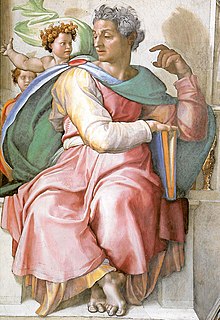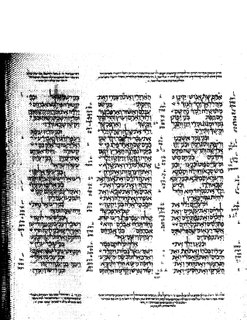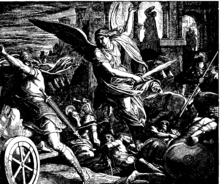
Hezekiah, or Ezekias, was the son of Ahaz and the 13th king of Judah according to the Hebrew Bible.

Isaiah was the 8th-century BC Israelite prophet after whom the Book of Isaiah is named.

The Assyriansiege of Jerusalem was a failed siege of Jerusalem, then capital of the Kingdom of Judah, carried out by Sennacherib, king of the Neo-Assyrian Empire. The siege concluded Sennacharib's campaign in the Levant, in which he attacked the fortified cities and devastated the countryside of Judah in a campaign of subjugation. Sennacherib besieged Jerusalem, but failed to capture it — it is the only city mentioned as being besieged on Sennacherib's Prism, of which the capture is not mentioned.

Matthew 1:10 is the tenth verse of the first chapter in the Gospel of Matthew in the Bible. The verse is part of the section where the genealogy of Joseph, the father of Jesus, is listed.

Matthew 1:9 is the ninth verse of the first chapter of the Gospel of Matthew in the Bible. The verse is part of the non-synoptic section where the genealogy of Joseph, the legal father of Jesus, is listed, or on non-Pauline interpretations the genealogy of Jesus. The purpose of the genealogy is to show descent from the line of kings, in particular David, as the Messiah was predicted to be the son of David, and descendant of Abraham.

The siege of Lachish was the Neo-Assyrian Empire's siege and conquest of the town of Lachish in 701 BCE. The siege is documented in several sources including the Hebrew Bible, Assyrian documents and in the Lachish relief, a well-preserved series of reliefs which once decorated the Assyrian king Sennacherib's palace at Nineveh.
Sennacherib's Annals are the annals of the Assyrian king Sennacherib. They are found inscribed on a number of artifacts, and the final versions were found in three clay prisms inscribed with the same text: the Taylor Prism is in the British Museum, the Oriental Institute Prism in the Oriental Institute of Chicago, and the Jerusalem Prism is in the Israel Museum in Jerusalem.

The Lachish reliefs are a set of Assyrian palace reliefs narrating the story of the Assyrian victory over the kingdom of Judah during the siege of Lachish in 701 BCE. Carved between 700 and 681 BCE, as a decoration of the South-West Palace of Sennacherib in Nineveh, the relief is today in the British Museum in London, and was included as item 21 in the BBC Radio 4 series A History of the World in 100 Objects by the museum's former director Neil MacGregor. The palace room, where the relief was discovered in 1845–1847, was fully covered with the "Lachish relief" and was 12 metres (39 ft) wide and 5.10 metres (16.7 ft) long. The Lion Hunt of Ashurbanipal sequence was found in the same palace.
Isaiah 7 is the seventh chapter of the Book of Isaiah in the Hebrew Bible or the Old Testament of the Christian Bible. This book contains the prophecies attributed to the prophet Isaiah and is one of the Books of the Prophets.
Isaiah 30 is the thirtieth chapter of the Book of Isaiah in the Hebrew Bible or the Old Testament of the Christian Bible. This book contains the prophecies attributed to the prophet Isaiah, and is one of the Books of the Prophets. The Jerusalem Bible groups chapters 28-35 together as a collection of "poems on Israel and Judah". The Cambridge Bible for Schools and Colleges describes this chapter as "a series of Oracles dealing with the Egyptian Alliance and its consequences; the present state and future prospects of Israel, and the destruction of the Assyrians".
Isaiah 36 is the thirty-sixth chapter of the Book of Isaiah in the Hebrew Bible or the Old Testament of the Christian Bible. This book contains the prophecies attributed to the prophet Isaiah, and is a part of the Book of the Prophets. The text, describing the invasion of the Assyrian king Sennacherib to the Kingdom of Judah under Hezekiah.
Isaiah 37 is the thirty-seventh chapter of the Book of Isaiah in the Hebrew Bible or the Old Testament of the Christian Bible. This book contains the prophecies attributed to the prophet Isaiah, and is a part of the Book of the Prophets.

2 Kings 16 is the sixteenth chapter of the second part of the Books of Kings in the Hebrew Bible or the Second Book of Kings in the Old Testament of the Christian Bible. The book is a compilation of various annals recording the acts of the kings of Israel and Judah by a Deuteronomic compiler in the seventh century BCE, with a supplement added in the sixth century BCE. This chapter records the events during the reign of Ahaz, the king of Judah.

2 Kings 18 is the eighteenth chapter of the second part of the Books of Kings in the Hebrew Bible or the Second Book of Kings in the Old Testament of the Christian Bible. The book is a compilation of various annals recording the acts of the kings of Israel and Judah by a Deuteronomic compiler in the seventh century BCE, with a supplement added in the sixth century BCE. This chapter records the events during the reign of Hezekiah, the king of Judah, a part of the section comprising 2 Kings 18:1 to 20:21, with a parallel version in Isaiah 36–39.

2 Kings 20 is the twentieth chapter of the second part of the Books of Kings in the Hebrew Bible or the Second Book of Kings in the Old Testament of the Christian Bible. The book is a compilation of various annals recording the acts of the kings of Israel and Judah by a Deuteronomic compiler in the seventh century BCE, with a supplement added in the sixth century BCE. This chapter records the events during the reign of Hezekiah and Manasseh, the kings of Judah.

2 Chronicles 32 is the thirty-second chapter of the Second Book of Chronicles the Old Testament in the Christian Bible or of the second part of the Books of Chronicles in the Hebrew Bible. The book is compiled from older sources by an unknown person or group, designated by modern scholars as "the Chronicler", and had the final shape established in late fifth or fourth century BCE. This chapter belongs to the section focusing on the kingdom of Judah until its destruction by the Babylonians under Nebuchadnezzar and the beginning of restoration under Cyrus the Great of Persia. The focus of this chapter is the reign of Hezekiah, king of Judah.

Sennacherib's campaign in the Levant in 701 BCE was a military campaign undertaken by the Neo-Assyrian Empire to bring the region back under control following a rebellion against Assyrian rule in 705 BCE. After the death of Sargon II, Sennacherib’s father, a number of states in the Levant renounced their allegiance to Assyria. The rebellion involved several small states: Sidon and Ashkelon and Byblos, Ashdod, Ammon, Moab, and Edom who then submitted to the payment of tribute to Assyria. Most notably, Hezekiah of Judah, encouraged by Egypt, joined the rebellion and was subsequently invaded by the Assyrians who captured most of the cities and towns in the region. Hezekiah was trapped in Jerusalem by an Assyrian army and the surrounding lands were given to Assyrian vassals in Ekron, Gaza, and Ashdod, however, the city was not taken and Hezekiah was allowed to remain on his throne as an Assyrian vassal after paying a large tribute. The events of the campaign in Judah are famously related in the Bible which culminate in an “angel of the Lord” striking down 185,000 Assyrians outside the gates of Jerusalem prompting Sennacherib’s return to Nineveh.

2 Kings 15 is the fifteenth chapter of the second part of the Books of Kings in the Hebrew Bible or the Second Book of Kings in the Old Testament of the Christian Bible. The book is a compilation of various annals recording the acts of the kings of Israel and Judah by a Deuteronomic compiler in the seventh century BCE, with a supplement added in the sixth century BCE. This chapter records the events during the reigns of Azariah (Uzziah) and his son, Jotham, the kings of Judah, as well as of Zechariah, Shallum, Menahem, Pekahiah and Pekah, the kings of Israel. Twelve first verses of the narrative belong to a major section 2 Kings 9:1–15:12 covering the period of Jehu's dynasty.

2 Kings 21 is the twenty-first chapter of the second part of the Books of Kings in the Hebrew Bible or the Second Book of Kings in the Old Testament of the Christian Bible. The book is a compilation of various annals recording the acts of the kings of Israel and Judah by a Deuteronomic compiler in the seventh century BCE, with a supplement added in the sixth century BCE. This chapter records the events during the reign of Manasseh and Amon, the kings of Judah.

2 Chronicles 33 is the thirty-third chapter of the Second Book of Chronicles the Old Testament of the Christian Bible or of the second part of the Books of Chronicles in the Hebrew Bible. The book is compiled from older sources by an unknown person or group, designated by modern scholars as "the Chronicler", and had the final shape established in late fifth or fourth century BCE. This chapter belongs to the section focusing on the kingdom of Judah until its destruction by the Babylonians under Nebuchadnezzar and the beginning of restoration under Cyrus the Great of Persia. It contains the regnal accounts of Manasseh and Amon, the kings of Judah.


























